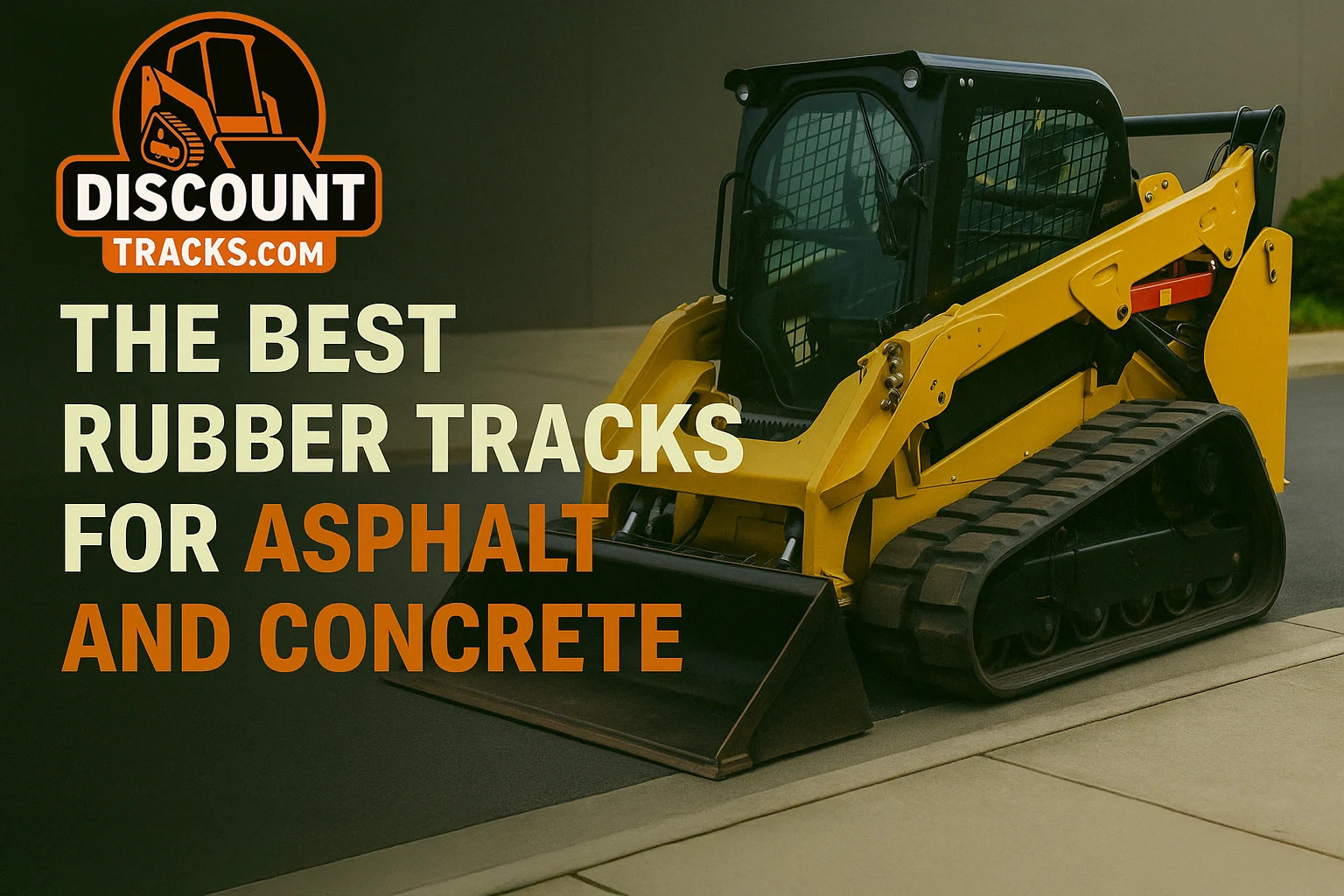Working on finished surfaces like asphalt and concrete demands more than just durable rubber tracks—it requires thoughtful selection to avoid costly surface damage. Whether you’re repairing roadways, trenching near driveways, or landscaping along sidewalks, the wrong tread pattern can lead to scuffs, gouges, and worn-down tracks.
The challenge? Finding a track tough enough to withstand abrasive surfaces while soft enough to minimize asphalt damage and prevent track marks on concrete. In this guide, we explore the essential features of the best rubber tracks for asphalt and concrete, using the Discount Tracks Tread Pattern Guide as our foundation for informed selection.
The Unique Challenges of Asphalt & Concrete Surfaces
Rubber tracks must handle these hard surfaces carefully and effectively. Here’s why:
- Surface Marking/Scuffing: Especially during sharp turns, black marks or streaks can be left on pavement.
- Gouging/Damage: Aggressive tread patterns can dig into freshly laid asphalt or decorative concrete.
- Accelerated Tread Wear: Asphalt and concrete are highly abrasive, wearing down rubber faster than dirt.
- Heat Buildup: Friction from tight turns and constant surface contact can raise track temperature, increasing wear risk.
Balancing track life and surface preservation is critical.
Selecting the Right Features for Hard Surface Work
Interpreting the Tread Pattern Guide for Concrete/Asphalt
The Concrete column in our Tread Pattern Guide gives helpful insight for general hard-surface performance:
- Block, Bar, and Zig Zag patterns are marked as either “Best” or “Better” for concrete, indicating good abrasion resistance and control.
However, when minimizing surface damage is your top priority, the specific tread design details become more important than just overall ratings.
Tread Patterns that Minimize Surface Marking
To reduce surface damage while maintaining durability:
- Prioritize Less Aggressive Designs:
- Patterns with wide, shallow lugs and rounded edges are less likely to scuff or dig.
- Tread blocks with more continuous rubber contact reduce pressure points that cause gouges.
Block / C-Block:
- Durable and versatile.
- Best when selected with less void space and rounded edges for smoother operation on pavement.
Bar / Zig Zag:
- Can offer good surface contact and control.
- Look for variations with low-profile designs to prevent digging or excessive friction.
Avoid:
- Deep-lug, aggressive tracks meant for mud or rocky terrain. These can gouge or tear into asphalt and wear out quickly.
Rubber Compound Matters
Look for rubber blends that are:
- Abrasion-resistant to endure tough surfaces.
- Formulated to reduce heat buildup.
Non-Marking Tracks?
Some manufacturers offer specialized non-marking rubber (typically gray or tan) designed for indoor concrete or decorative outdoor settings. While effective at avoiding marks, these tracks can have shorter wear life or higher costs. Discount Tracks currently focuses on low-marking black rubber options that deliver a strong balance of durability and performance.
Consider Smooth / Turf-Friendly Patterns
In ultra-sensitive areas (e.g., decorative concrete), smoother tread options or turf-designated tracks may help. However, be cautious:
- These may have shorter lifespan on abrasive surfaces.
- Best used when surface preservation outweighs track longevity.
Operational Techniques to Protect Surfaces
Even with the right track, operator technique plays a major role:
- Make wide, gradual turns to reduce friction and skid marks.
- Avoid spinning or counter-rotating unless absolutely necessary.
- Keep tracks clean of embedded gravel or debris that can grind against the pavement.
Discount Tracks: Balancing Durability and Surface Care
At Discount Tracks, we understand the importance of protecting your paved surfaces and your equipment investment. Our track options include several Block, Bar, and Zig Zag designs ideal for asphalt and concrete conditions, offering:
- Reduced surface marking compared to overly aggressive patterns.
- Durable construction to handle abrasive wear.
- Cost-effective pricing for long-term value.
Whether you’re working with a mini excavator on concrete slabs, a skid steer around driveways, or a CTL on asphalt overlays, we offer tracks that help you avoid costly surface damage.
Need help choosing the right style? Our team is ready to guide you based on your application and machine.
Conclusion: Protect Your Surface & Your Tracks
Choosing the best rubber tracks for asphalt and concrete is about balance: you want tread patterns and rubber compounds that minimize damage while still offering long-term wear resistance.
Less aggressive, flatter treads with abrasion-resistant rubber are usually best for hard surfaces.
Protect your pavement and your budget!
Explore Discount Tracks’ collection of durable, pavement-friendly rubber tracks at DiscountTracks.com, or contact our experts for personalized recommendations. We’ll help you find the best value tracks for pavement applications that get the job done—without leaving a mark.


